Crucial P310 2TB Performance Testing
We test using both the default smaller test size and larger test sets on our benchmarks. This allows us to see the difference between lighter and heavier workloads.
A note for testing this drive: I don’t have any other 2TB 2230 sized drives in my testing database as of yet, so the P310 will be at a small advantage compared to the smaller drives. With that said, the smaller 1TB P310 has identical rated performance specs, so perhaps not.
CrystalDiskMark x64
CrystalDiskMark is used as a basic starting point for benchmarks as it is something commonly run by end-users as a sanity check.


Right up front in CrystalDiskMark, the Crucial P310 2TB hit the mark for its rated performance specifications and takes the performance crown over any previous 2230 sized drives I have reviewed. In fact, the P310 tops the chart entirely compared to the drives I have been using to test against 2230 drives, which includes some 2280 sized models. So far the P310 is shaping up to be a high performance 2230 contender.


When I found out the P310 was QLC based, I knew the testing had the potential to be interesting. Well, here you go; results that are interesting. The Crucial P310 performance on the larger CrystalDiskMark craters on the write speed, while taking a small dip in read performance. This is far from the first time I have seen this kind of behavior out of QLC. With that said, write performance still stays in NVMe territory (if only just) and these drives are intended for a mostly read-intensive workload. Even 650 MB/s write speed is faster than the Wi-Fi on a Steam Deck, so it is unlikely to pose an issue for a gamer.
ATTO Disk Benchmark
The ATTO Disk Benchmark has been a staple of drive sequential performance testing for years. ATTO was tested at both 256MB and 8GB file sizes.
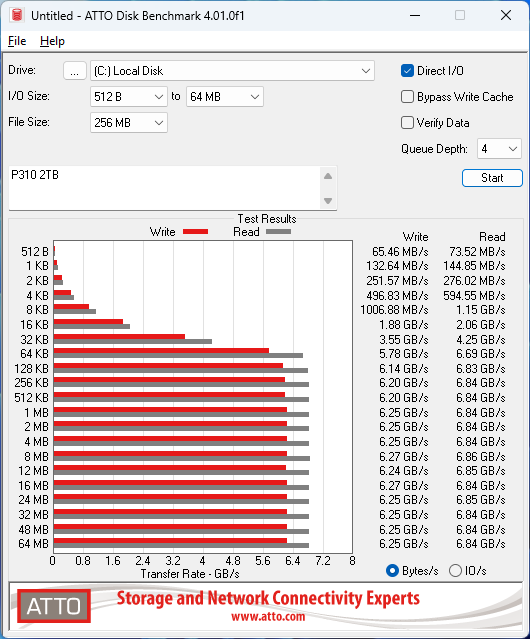

ATTO sequential results show the Crucial P310 returning to form and once again topping the results chart. Many drives I review have an interaction with ATTO that causes falsely inflated test results, and the P310 is exceeding its rated write speed by quite a bit here. More important than the absolute results, though, is the consistency of the results. We want similar results at all data points in the test, and the P310 manages to deliver just that.

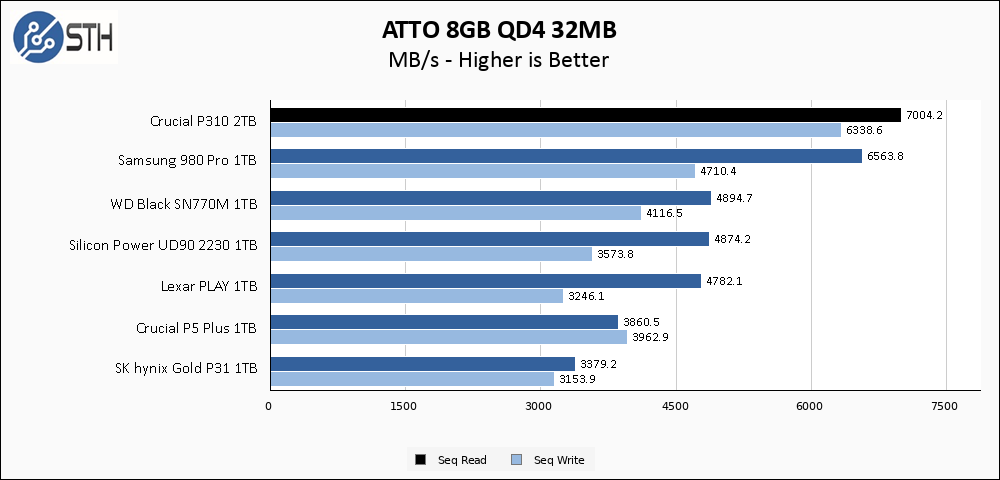
The larger ATTO test shows a negligible difference in performance, which is what I always want to see. Once again I am not 100% confident of the absolute results presented here, but I am very impressed with the consistency across the test.
Anvil’s Storage Utilities
Anvil’s Storage Utilities is a comprehensive benchmark that gives us a very in-depth look at the performance of the drives tested. This benchmark was run with both a 1GB and 8GB test size.


Anvil results for the Crucial P310 2TB are good, with read score results nearly topping the chart and write score winning outright. Of course, these are on the lightweight version of the Anvil test…
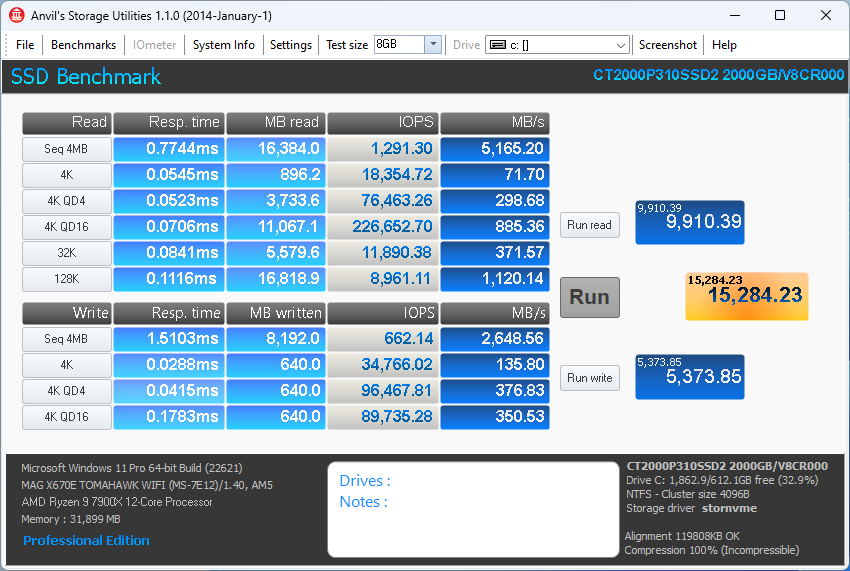
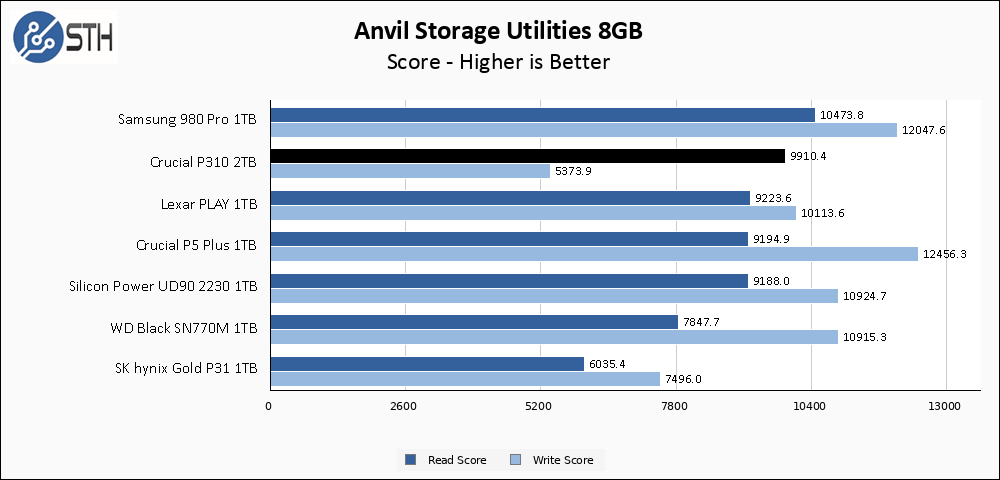
Once again the Crucial P310 takes a significant write performance knock on the larger test. The drop-off is less significant than it was in CrystalDiskMark, but it is still obviously present. Read performance, the focus point for the P310, actually improves on the larger Anvil test, which is great to see.
AS SSD Benchmark
AS SSD Benchmark is another good benchmark for testing SSDs. We run all three tests for our series. Like other utilities, it was run with both the default 1GB as well as a larger 10GB test set.


Performance in AS SSD for the P310 is pretty staggering. The 1GB AS SSD test shows the P310 winning in read score versus the competition, and absolutely trouncing everything in write score. The P310 seems to do very well with small burst write traffic patterns.
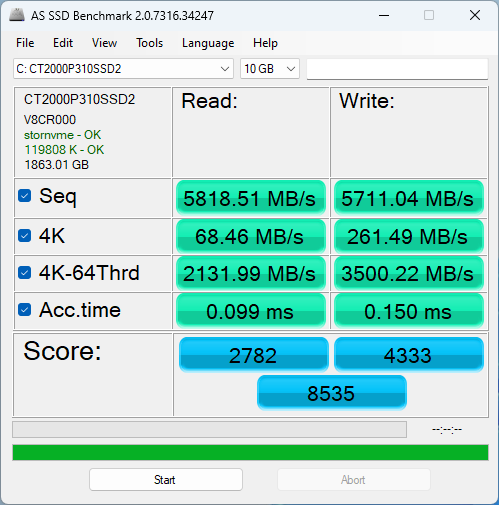
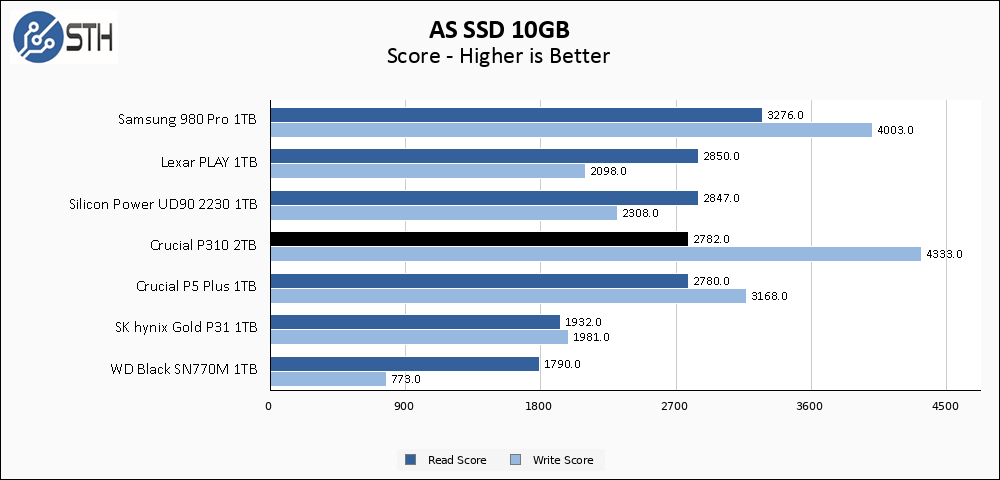
The Crucial P310 takes a hit on the larger AS SSD test, though most of the hit this time comes from a tumble in read score. Write score in AS SSD still manages to be chart-topping, though by a relatively slim margin this time rather than the outsized lead in the 1GB test.
SPECworkstation, thermals, and our conclusion are up next.




It would be interesting to have a benchmark that reflects the typical “download game at from steam and decompress it simultaneously” workload. At which point does the drive become the limiting factor rather than the network? Some QLC drives become a heavy bottleneck if you have 1Gbit/s download speed if they’re nearing full.
Thomas,
This drive did not dip that low, even when it was 85% full. It maintained 300+ MB/s write speed.
@Thomas. In that use case the CPU is always the limiting factor, the drive speed will always be sufficient.
Personally I’d prefer a 1GB/s transfer rate but at 16TB and for about £200.
Don’t really mind the form factor.
I understand this won’t happen due to market forces, but still, nice to dream.
Cooling does seem ahem, crucial. We’ve found lots of good cooling solutions for 2280 drives but will need to look into solutions that can work where we are using these for 2230-sized ones. Thatbeing said, there are several use cases in our environment where the physically smller ones would be useful, and this seems like a good option.
Im sending mine back, it is heavily thermal throttling to the point where read / writes are sitting around 60MB/s in an open case. This was when actually trying to image to a new drive with the P310 as the source. It was running very hot when idle and once you start to do anything involving transfers its straight to the 85c mark and crawling.